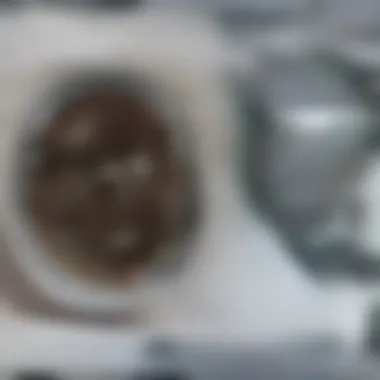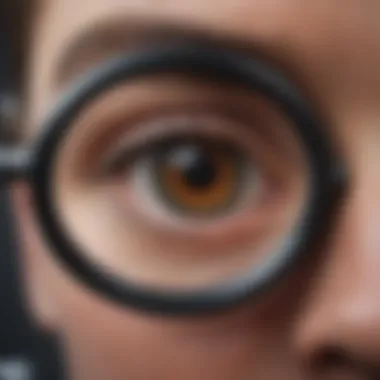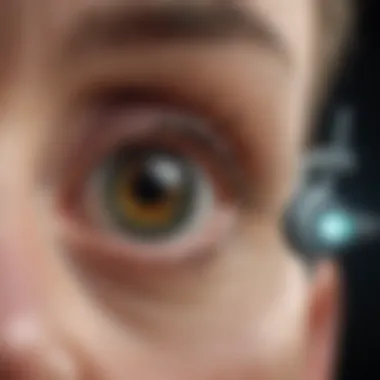Cataract Measurements: Enhancing Surgical Outcomes


Research Context
Background and Rationale
Cataracts represent a significant public health concern globally. The lens of the eye becomes cloudy with age, impacting vision and overall quality of life. Understanding how to measure cataracts precisely is critical. Accurate measurements can guide effective treatment options and improve surgical outcomes. With the shift towards more tailored treatment plans, the significance of cataract measurements cannot be overstated.
In recent years, advancements in technology have changed the landscape of how these measurements are carried out. This article aims to illuminate the importance of cataract measurements in contemporary ophthalmic practice. It explores various methodologies, from traditional to newly developed techniques, underscoring their applications in diagnosis, treatment planning, and post-operative monitoring.
Literature Review
Research on cataract measurement has evolved substantially, integrating knowledge from optometry, ophthalmology, and innovative engineering fields. Studies demonstrate that precise measurements correlate with favorable surgical results and better recovery experiences for patients. According to a review published in Ophthalmology Journal, integrating optical coherence tomography with standard measurement techniques has shown promise in enhancing accuracy. This review indicates a consensus among experts about the need for ongoing research, particularly in refining measurement protocols and understanding their implications on long-term outcomes.
This article will synthesize current research, thus providing a holistic look at how cataract measurements inform clinical practice today.
Methodology
Research Design
The methodology for investigating cataract measurements focuses on examining existing literature while integrating findings from current clinical practices. This approach allows for a comprehensive indeed understanding of the subject. The examination covers diverse technologies and assessment tools used in measuring cataracts, such as A-scans, B-scans, and newer imaging modalities such as Scheimpflug imaging.
Data Collection Methods
Data collection involves sourcing peer-reviewed journals, clinical trials, and systematic reviews, ensuring the information is credible and relevant. Studies are chosen based on their contribution to evolving techniques in cataract measurement.
- Inclusion criteria:
- Exclusion criteria:
- Recent studies from the last decade.
- Publications focused on methodology improvements.
- Papers lacking empirical data.
- Older studies without contemporary relevance.
This detailed examination will contribute to a better understanding of the precision required in cataract measurement, ultimately aiding in improving patient outcomes in the field of eye surgery.
Intro to Cataract Measurements
Cataract measurements play a pivotal role in the diagnosis and treatment of cataracts. Understanding how cataracts form, why they need to be measured, and the methods to achieve this precision is crucial for successful surgical interventions. A well-defined measurement process aids in crafting tailored treatment plans. Consequently, this ensures improved outcomes for patients.
Defining Cataracts
Cataracts are characterized by the clouding of the lens in the eye, which can lead to decreased vision. They are commonly linked to aging but can also result from other factors, including genetics, diabetes, and prolonged exposure to UV light. The nature of cataracts can vary significantly, impacting the approach a surgeon might take. In this context, defining the type and extent of cataracts becomes essential for determining the correct measurement techniques.
Importance of Measurement in Cataract Surgery
The importance of accurate measurement in cataract surgery cannot be overstated. Precise measurements guide the selection of the intraocular lens, a crucial component for restoring vision post-surgery. Without proper measurement, the surgeon may choose the wrong lens, leading to complications or suboptimal visual outcomes. Additionally, accurate cataract assessment assists in identifying the cataract type and severity. This helps predict surgical challenges and optimize operating procedures.
Accurate measurements can substantially reduce the risk of postoperative complications, enhancing patient satisfaction and overall quality of life.
Moreover, regular assessment using diverse measurement techniques informs the continuing care of patients, facilitating timely intervention if cataracts worsen. This comprehensive approach not only promotes individual well-being but also contributes to broader public health outcomes, as patients regain the ability to engage in everyday activities effectively.
Types of Cataracts


Cataracts can manifest in different forms, each with its specific characteristics and impact on vision. Understanding the various types is essential for effective diagnosis and treatment planning. Knowing the distinctions allows eye care professionals to tailor surgical approaches to the individual patient's needs. Each type of cataract can affect vision differently, requiring targeted measurement techniques to assess severity and guide intervention. This section will elaborate on the three primary types of cataracts: nuclear cataracts, cortical cataracts, and posterior subcapsular cataracts.
Nuclear Cataracts
Nuclear cataracts are commonly associated with the aging process. This type involves the gradual clouding of the lens's central region, which can lead to changes in vision. A key symptom is a change in color perception, often noting a yellowing or browning effect in the lens. Additionally, patients may experience improved near vision, sometimes referred to as "second sight," before the condition worsens and leads to more significant vision impairments.
Measurement techniques for nuclear cataracts often focus on visual acuity and lens density. As the lens becomes denser, it can significantly affect light transmission, necessitating precise measurements to determine the severity of the cataract. Optical coherence tomography (OCT) and slit-lamp examinations are commonly used for this purpose, providing valuable insights into the cataract's progression.
Cortical Cataracts
Cortical cataracts develop in the outer layer of the lens. This type is characterized by white opacities that often resemble spoke-like patterns extending from the periphery towards the center. Patients with cortical cataracts may find it challenging to see in bright light or experience glare. The gradual progression can lead to difficulties with depth perception as well, affecting daily activities.
Accurate measurement of cortical cataracts is vital for assessing their impact on vision. Tools such as slit-lamp examinations are essential for determining the extent of opacity. It is also important to evaluate how these changes affect the patient's quality of life, as even minor impairments can be disruptive.
Posterior Subcapsular Cataracts
Posterior subcapsular cataracts occur at the back of the lens. They can develop rapidly and often are linked to specific conditions, such as diabetes or prolonged use of corticosteroids. This type leads to difficulty reading in bright light and can cause significant glare issues, impacting daily life.
Measurement for posterior subcapsular cataracts requires a comprehensive assessment. Techniques like OCT and biometry play a critical role in understanding the cataract's implications on visual acuity. Understanding the dynamics of this type helps guide timely intervention to improve patient outcomes.
"Each type of cataract presents unique challenges that must be understood for effective surgical planning."
In summary, recognizing the various types of cataracts is vital for accurate measurement and effective treatment strategies. Each type affects vision in distinct ways, highlighting the need for tailored approaches in evaluation and surgery.
Measurement Techniques
In the field of ophthalmology, precise measurements are crucial for the effective management of cataracts. Measurement techniques are tools that help clinicians evaluate the extent and characteristics of cataracts, which in turn shapes treatment decisions. Accurate measurements support the planning and execution of surgical interventions, ultimately impacting patient outcomes.
Visual Acuity Assessment
Visual acuity assessment is often the first step in understanding the degree of visual impairment caused by cataracts. This technique measures how well a patient can see at various distances. The Snellen chart is typically used for this purpose, providing a standardized method to gauge visual clarity. By comparing visual acuity scores before and after treatment, clinicians can determine the effectiveness of surgical interventions, thus reinforcing its clinical significance.
Slit-Lamp Examination
The slit-lamp examination allows for a detailed view of the anterior segment of the eye, including the lens where cataracts develop. This technique combines a high-intensity light source with a microscope, allowing practitioners to observe the morphology and density of cataracts. The advantage of this method lies in its ability to reveal the structural characteristics of cataracts, which informs the surgical approach. Additionally, this examination aids in distinguishing between different types of cataracts, guiding treatment options for individual patients.
Optical Coherence Tomography (OCT)
Optical Coherence Tomography is a non-invasive imaging technique that captures cross-sectional images of the retina and lens. OCT provides high-resolution images, allowing for the examination of the lens architecture and any potential abnormalities caused by cataracts. This advanced method enhances diagnostic accuracy and helps in assessing the progression of cataract formation. The information obtained from OCT can be pivotal in determining the optimal timing for surgical intervention, which is essential for preserving visual function.
Ultrasound Biometry
Ultrasound biometry measures the dimensions of the eye, particularly the axial length, which is essential for calculating the appropriate intraocular lens power to be implanted during cataract surgery. This technique employs ultrasonic waves, which can penetrate the eye's tissues. By analyzing the reflected sound waves, clinicians can derive measurements that are critical for achieving optimal post-surgery refractive outcomes. Ultrasound biometry is especially advantageous in cases where other methods cannot provide accurate readings, such as in dense cataracts.
Advances in Measurement Technologies
The realm of cataract measurements has seen significant advancements in recent years. These developments are crucial as they directly impact the accuracy of diagnoses and the overall success of surgical interventions. Enhanced measurement technologies facilitate better outcomes for patients and streamline the decision-making process for ophthalmologists. Understanding these innovations is essential for those involved in the ocular health field.
Innovations in Imaging Techniques
Recent innovations in imaging techniques have revolutionized how cataracts are diagnosed and monitored. High-resolution imaging methods allow clinicians to visualize the eye's structures with remarkable clarity, aiding in precise assessments. Techniques such as digital fundus photography and wide-field imaging enable a more detailed picture of the lens and surrounding tissues.


- Digital Fundus Photography: This method captures detailed images of the retina and can reveal other ocular conditions that may accompany cataracts.
- Wide-Field Imaging: By providing a panoramic view of the retina, this technique helps in evaluating the overall health of the eye and identifying complications early.
Another notable development is the integration of Optical Coherence Tomography (OCT) into cataract assessments. OCT provides cross-sectional images of the retina and surrounding structures, allowing for detailed evaluation of cataract morphology. This real-time imaging capability enhances diagnostic accuracy significantly.
Artificial Intelligence in Cataract Measurement
The advent of artificial intelligence (AI) technology has introduced a new paradigm in cataract measurement practices. AI algorithms can process vast amounts of data rapidly, identifying patterns and anomalies that may escape human observation. This has potent implications for clinical practice.
- Automated Detection: AI systems can assist in the automatic detection and grading of cataracts from imaging data, thus reducing the burden on specialists.
- Predictive Analytics: Machine learning models can analyze historical data to predict surgical outcomes, assisting surgeons in choosing optimal treatment strategies.
AI technology can streamline clinical workflows and enhance decision-making in cataract surgeries, making it a powerful tool in modern ophthalmology.
Furthermore, the combination of AI with existing measurement technologies can lead to improved personalization of treatment plans. This shift towards more tailored healthcare reflects the evolving landscape of eye care, where precision is becoming increasingly attainable.
Clinical Significance of Measurements
Cataract measurements serve a vital function in the realm of ophthalmology. Precise metrics ensure that surgical decisions are supported by reliable data, ultimately influencing the outcomes for patients undergoing cataract surgery. Understanding these measurements is not simply an academic exercise; it is a cornerstone of effective clinical practice.
Influence on Surgical Outcomes
The success of cataract surgery largely hinges on accurate measurements. Intraocular lens (IOL) selection is perhaps the most critical aspect influenced by these measurements. For instance, biometry involves measuring the eye's dimensions to determine the most appropriate lens power. When measurements are precise, the likelihood of achieving optimal visual acuity post-surgery increases significantly.
- Factors influenced by measurement accuracy include:
- IOL power calculation.
- Lens positioning relative to the eye's optical axis.
- Overall surgical technique and execution.
Inaccurate measurements can lead to various complications, such as residual refractive errors or the need for additional surgical interventions. This not only affects patient satisfaction but can also impose additional costs on healthcare systems. Thus, maintaining high standards in measurement techniques is essential.
Patient Quality of Life Post-Surgery
Post-operative quality of life is closely tied to the accuracy of pre-surgical measurements. When cataract measurements are conducted expertly, patients typically experience better vision restoration.
Some benefits include:
- Enhanced visual outcomes, allowing for greater independence in daily activities.
- Improved satisfaction levels, which correlates with better mental health and social interaction.
- Reduced dependency on glasses or contact lenses, leading to a sense of freedom and increased lifestyle options.
Accurate cataract measurements directly correlate with improved patient satisfaction and a positive impact on quality of life post-surgery.
Challenges in Accurate Measurement
The accuracy of cataract measurements is paramount in ensuring successful surgical outcomes. Various factors can influence the precision of these measurements, and understanding these challenges is essential for eye care professionals. This section examines the significant aspects that contribute to measurement inaccuracies, focusing on the methods applied and the implications for patient care.
Variability in Measurement Techniques
Measurement techniques for cataracts differ widely. These variations arise from the devices used, the skill level of the practitioner, and the conditions under which measurements are taken. When various devices are applied, such as optical coherence tomography (OCT) or ultrasound biometry, discrepancies in outputs may occur due to differences in technology calibration and data interpretation.
For example, optical coherence tomography offers detailed imaging of the retina and anterior segment, while ultrasound biometry relies on sound waves to measure ocular dimensions. Each method has its strengths and limitations, resulting in different measurements being reported for the same cataract. This variability can lead to inconsistent treatment plans that may affect the overall surgical success.
- Inconsistencies may arise from:


- Calibration of devices
- Operator proficiency
- Patient positioning during measurement
Hence, it is necessary to standardize measurement techniques across clinical practices. Doing so can improve reproducibility and reliability of cataract assessments, ultimately leading to better surgical outcomes.
Patient-Related Factors Affecting Measurements
Beyond technical factors, patient-related variables also significantly impact the accuracy of cataract measurements. Factors such as age, pupil size, and the presence of other ocular conditions can introduce variability. For older adults, a common population affected by cataracts, physiological changes can distort measurements, contributing to challenges in achieving precise outcomes.
Specific aspects include:
- Pupil size: If the pupil is not adequately dilated during examination, measurements may be less accurate. Non-dilated pupils can hide areas of the lens, leading to misinterpretation of cataract severity.
- Ocular health: Other existing eye conditions, like glaucoma or diabetes, may affect the shape and structure of the eye, complicating cataract assessments.
- Patient cooperation: The patients' ability to follow instructions during the measurement process is also vital. Anxiety, discomfort, or medical issues might hinder the reliability of the measurements.
Accurate cataract measurements are critical for effective surgical planning and execution, and understanding both variability in techniques and patient-related factors is essential for improving surgical outcomes.
These challenges emphasize the need for continued education and research focused on improving measurement accuracy. By addressing these issues, healthcare professionals can enhance the quality of cataract surgery, leading to better visual outcomes for patients.
Future Directions in Cataract Measurements
The landscape of cataract measurements is evolving rapidly, driven by technological advancements and scientific research. Understanding future directions is crucial for enhancing diagnostic and surgical precision. This section explores the evolving nature of cataract measurements and their implications for patient care.
The Role of Personalized Medicine
Personalized medicine is poised to transform cataract treatment. By tailoring measurements to individual patient needs, practitioners can significantly improve surgical outcomes. For instance, genetic profiling may help to predict how a patient's eyes respond to different surgical techniques.
- Custom Solutions: Each patient presents unique anatomical and physiological characteristics. Personalized measurements ensure that treatment plans reflect these nuances, allowing for better surgical precision.
- Enhanced Recovery: When techniques align closely with patient profiles, recovery times tend to decrease. Patients may experience fewer complications and improved overall satisfaction.
The integration of personalized data can also influence the choice of intraocular lenses, thus optimizing visual acuity post-surgery.
Emerging Research Areas
Research in cataract measurements is continuously uncovering new methodologies and technologies. Some of the areas on the cutting edge of this field include:
- Machine Learning Applications: Developing algorithms that analyze large datasets of imaging and measurement can provide insights into optimal surgical practices. This approach may lead to predictive models that suggest the best outcomes based on specific patient data.
- Biomarkers for Cataract Progression: Identifying and validating biomarkers can aid in early detection of cataract formation. These markers may eventually offer non-invasive ways to predict the severity and progression of cataract development.
- Advancements in Imaging Technologies: Innovations in imaging techniques, such as enhanced high-resolution MRI or novel optical devices, hold the potential to offer unprecedented accuracy in measuring cataracts, enabling earlier intervention.
Exploring these areas is critical for the future efficacy of cataract treatments. The direction of research will not only define new methodologies but also set the stage for best practices in patient care.
"The journey toward accurate and personalized cataract measurement continues to be paved with technological ingenuity and patient-centric approaches."
This comprehensive understanding of future directions is essential, as it paves the way for better outcomes and enhanced patient experiences in the realm of cataract surgery.
Epilogue
The conclusion of this article serves as a significant synthesis of the various aspects of cataract measurements discussed throughout. Understanding these measurements is crucial for enhancing surgical outcomes and ensuring that patients regain their functional vision post-surgery. This article has elaborated on several topics, showcasing the complexity and precision required in cataract surgery.
Summary of Key Findings
Cataract measurements play a vital role in multiple stages of the surgical journey. Key findings include:
- The variety of measurement techniques, such as visual acuity assessments and optical coherence tomography, and their importance in pre-operative evaluations.
- The advances in technology, particularly in imaging and the use of artificial intelligence, which refine the accuracy of these measurements.
- The strong correlation between precise measurements and positive surgical outcomes, emphasizing the necessity for meticulous planning in the surgical process.
The Importance of Ongoing Research
Ongoing research is essential in the realm of cataract measurements for several reasons:
- Continuous innovation allows for the development of more advanced measurement tools, which can lead to improved surgical outcomes.
- As personalized medicine gains traction, tailored approaches to cataract treatment can be developed, thereby enhancing patient experience.
- Furthermore, research into patient-related factors and variability in measurement techniques can contribute to standardizing practices across different settings.
Understanding the elements that affect the accuracy of cataract measurements, and the subsequent impact on patient quality of life, is crucial. Thus, a commitment to ongoing research will not only bolster the methodologies used but also promote greater efficacy in the treatment and care of patients who endure cataracts.



